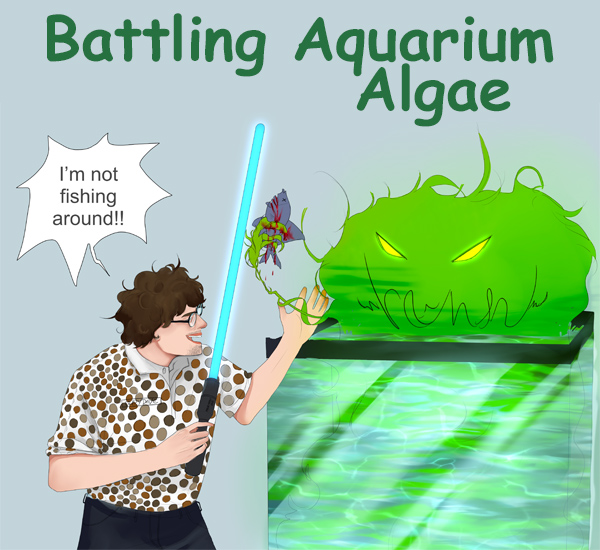Is it necessary to battle algae with a Jedi Lightsaber like Crazy Dave? We don't judge, but perhaps there are better ways to fight algae.
1. Scrub It Out
This may seem obvious, but manually scrubbing algae can go a long way in removing it from your aquarium. Itís best to remove the algae rather than just scrubbing it off a surface. If you knock the algae off the glass and rocks, but donít remove it, it can simply reattach to new surfaces and grow again. When doing water changes with a gravel vac you can remove the algae you scrubbed off. We carry a number of algae scrub pads and algae magnets.
2. Add Herbivores
Add plecostomus, shrimp, otocinclus, flag fish, and snails to freshwater aquariums, or add snails, crabs, blennies, tangs, limpets, and sea urchins to saltwater aquariums for algae control. These animals remove the algae for you so you donít have to scrub as much.
3. Feed Less
Algae is photosynthetic; it uses light, CO2, and nutrients to grow. Overfeeding the tank can lead to excess nutrients and lots of algae. Only feed your fish what they will eat and stock your tank at reasonable levels to reduce the amount of nutrients entering the water.
4. Reduce Light
Algae needs light to survive. Limiting light to only the spectrum, duration, and intensity needed for your fish, plants, and coral can help reduce algae.
Light spectrum that is more warm or red in color can increase algae growth. Reduce this color by adjusting your LED lights (if possible). Replace your florescent lamps yearly because over time the color can shift towards the red end of the light spectrum.
Light duration should be limited to that which is naturalóusually between 6-12 hours a day. If you experience algae problems, try cutting down your photoperiod to 6 hours. Keep in mind that while the sun may be up for 12 hours in nature, the sun is not equally bright all day. Using LED lights that have dawn/dusk effects can allow you to run your lights longer without having them at their maximum intensity all day.
Extremely bright light can also cause algae growth. If you donít have coral or plants, then only use enough light to view the fish. If you do have coral or plants, then make a sensible lighting choice that is not brighter than needed. Or, choose an adjustable LED light that you can turn down if it proves too intense.
5. Raise pH
Low pH can cause algae because it is linked to high CO2 levels that help algae grow. Raise pH by properly ventilating the aquarium, adding pH buffers, or using kalkwasser in saltwater aquariums. You can also lower CO2 levels using a CO2 Scrubber.
6. Increase Flow
Many types of algae like stagnant water. High water flow is usually desirable because it keeps debris suspended where it can be removed from the tank. Some of the most difficult algaes to remove, such as cyanobacteria or blue green algae, can completely disappear with high flow. Use power heads such as Rossmont Movers or Hydor Koralias to increase flow.
7. Add Extra Filtration
Because nutrients are the root cause of algae in most cases, boosting your filtration can help starve out nuisance algae. There are several ways to upgrade your filtration.
Adding chemical filtration media to your filter is an easy way to help get rid of algae. Carbon, resins, and phosphate removers can all help to reduce algae. Phosphate removers in particular are very effective at stopping algae growth. Some good choices are Coral Vue GFO, Seachem PhosGuard, and Blue Life Phos FX.
Using a refugium to prevent algae blooms in saltwater tanks can help a lot. A refugium is a refuge where you grow a seaweed-like algae to out-compete nuisance algae in your tank. If you have a sump, you can use the refugium that came with it or add a Fiji Cube Hang-on Refugium or CPR Aquatic In-Tank Refugium. If you have an aquarium with a back filtration chamber, then one of the chambers can be made into a refugium with the introduction of a light such as the Tunze Eco Chic LED Light. Using a high-powered light such as the Kessil H80 Tuna Flora LED Light can greatly enhance your refugium's effect.
8. Use a UV Sterilizer
A UV sterilizer can help remove free-floating algae and stop the spread of other algaes. A UV sterilizer is a UV lamp that water is pumped around. When algae and microorganisms travel through the UV sterilizer, the UV light mutates and kills them. This makes UV sterilizers extremely effective at killing free-floating algae that cause green-tinted water. It can also stop algae from spreading by killing algae spores and killing algae that you scrub off of the glass and rocks before it reattaches to a new surface. We have a very large selection of UV sterilizers. Let us know if you need a recommendation.
9. Try Algaecides
We do not recommend trying an algaecide as the first step in eliminating algae, but when algae proves particularly stubborn using algaecides can make a profound impact on the nuisance algae in your tank. Blue Life RedCyano RX and ChemiClean are both extremely effective at eliminating the difficult to remove Cyanobacteria algae.
10. No Single Step Will Eliminate An Algae Problem
No single step will completely take care of your algae problem. You will likely have to use many of the steps on this list if your algae outbreak is particularly bad. For example, if you see a bloom of hair algae you might need to scrub the algae off with a toothbrush while siphoning out what you scrubbed, then add some Phosguard to your filter. Then add a sea urchin and some hermit crabs to eat the leftover algae you missed. Finally, readjust your led lights to a lower setting and reduce your feeding to prevent it from returning.
|




























